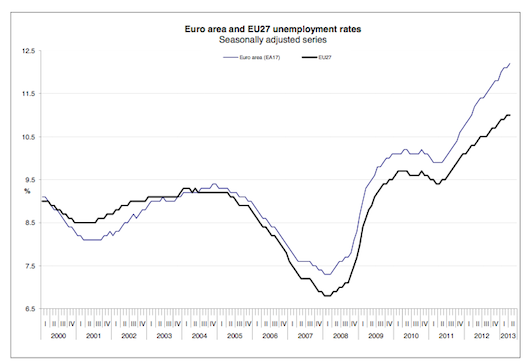Another month goes by and once again unemployment in the Eurozone targets the moon:
The euro area (EA17) seasonally-adjusted unemployment rate was 12.2% in April 2013, up from 12.1% in March. The EU27 unemployment rate was 11.0%, unchanged compared with the previous month. In both zones, rates have risen markedly compared with April 2012, when they were 11.2% and 10.3% respectively. These figures are published by Eurostat, the statistical office of the European Union.Eurostat estimates that 26.588 million men and women in the EU27, of whom 19.375 million were in the euro area ,were unemployed in April 2013. Compared with March 2013, the number of persons unemployed increased by 104 000 in the EU27 and by 95 000 in the euro area. Compared with April 2012, unemployment rose by 1.673 million in the EU27 and by 1.644 million in the euro area.
Among the Member States, the lowest unemployment rates were recorded in Austria (4.9%), Germany (5.4%) and Luxembourg (5.6%), and the highest in Greece (27.0% in February 2013), Spain (26.8%) and Portugal (17.8%). Compared with a year ago, the unemployment rate increased in eighteen
Member States and fell in nine. The highest increases were registered in Greece(21.9% to 27.0% between February 2012 and February 2013), Cyprus
(11.2% to 15.6%), Spain (24.4% to 26.8%) and Portugal (15.4% to 17.8%). The largest decreases were observed in Latvia (15.5% to 12.4% between the first quarters of 2012 and 2013), Estonia (10.6% to 8.7% between March 2012 and March 2013) and Ireland (14.9% to 13.5%)
France saw a record number of unemployed in April, while Italy now as has a rate not seen in over 35 years and both countries have recently had their growth estimates downgraded by the OECD with the expectation of further deterioration in employment. For Europe’s future the data is again much much worse, with the periphery producing such woeful numbers they are hard to even believe:
In April 2013, 5.627 million young persons (under 25) were unemployed in the EU27, of whom 3.624 million were in the euro area. Compared with April 2012, youth unemployment rose by 100 000 in the EU27 and by 188,000 in the euro area. In April 2013, the youth unemployment rate was 23.5% in the EU27 and 24.4% in the euro area, compared with 22.6% in both zones in April 2012.
In April 2013, the lowest rates were observed in Germany (7.5%), Austria (8.0%) and the Netherlands (10.6%), and the highest in
Greece (62.5% in February 2013), Spain (56.4%), Portugal (42.5%) and Italy (40.5%).
Given these number and the trend, it comes as no surprise to read about the on-going rise of parties such as golden dawn in Greece.
Since around the beginning of this year the highly optimistic statements out of the European Commission and the ECB have been that this year would be the year that growth began to return to the EZ. This is looking increasingly hard to sell and once again I do have to wonder about the social and political stability of nations where half the youth are looking for work but can’t find a job.
Over the last month we have seen what looks to be a shift in policy direction from some key players, such as Germany’s Schaeuble, and youth unemployment appears to have been a major contributor to this. Certainly the recent Franco-German statement on stability and growth, although highly confused, remarks on the need to address the issue as a matter of priority. As I said in that previous post we have already seen some initiatives from the German government to loosen the hand-brake on wage inflation, which is a positive step in terms of assisting with the internal rebalancing of the zone, and if the latest retail PMI data is correct then there is some signs that internal demand is picking up in Germany:
May’s retail survey provides grounds for optimism that private consumption growth will boost German GDP in the second quarter and help offset weakness in external demand. Retailers in Germany pointed to the strongest monthly rise in sales since mid-2012, and a rise in confidence about the near-term outlook for consumer spending led to greater job creation in the sector. In addition to these positive developments, May data indicated that increased sales and softer cost inflation led to the lowest pressure on retailers’ margins for almost two-and-a-half years.
So once again the data is woeful, but there is a glimmer of hope for the future, at least in words, as the Eurocrats slowly back away from their failed hard line.
